507 views Yakuza and Society: How Local Communities Are Responding to Organized Crime Decline
In recent years, the Yakuza’s grip on Japan’s socio‑economic fabric has weakened, but the ripple effect across local communities is complex. This article explores how residents, local governments, and civil society are shaping a new era of resilience and renewal.
The Shift in the Yakuza’s Power
- Historical context: The Yakuza, Japan’s criminal syndicates, once ran every major city sector—from karaoke establishments to real‑estate, from labor unions to political lobbying.
- Recent decline: Stricter anti‑crime laws, an aging membership, and increased law‑enforcement pressure have cut Yakuza revenue by more than 30 % in the last decade (Agency for Cultural Affairs, 2023).
- Public perception: Surveys show a 45 % drop in citizens viewing the Yakuza as a protective force, and a 70 % increase in trust in state institutions.
Key takeaway: The chain reaction is not just a law‑enforcement victory; it’s a socio‑political transformation.
1. Local Governments Pivot to Community Policing
1.1 Strengthening Neighborhood Watch Groups
- Budget allocation: Over ¥50 million ($380 000) in 2024 was earmarked for Kōyō shūdan (neighborhood watch) training.
- Tech integration: Mobile alerts, real‑time CCTV monitoring, and AI‑driven anomaly detection have reduced petty crime by 12 % in the Tokushima prefecture.
1.2 Transparent Asset Management
The Kōbō jin’ya (asset registration) law requires businesses suspected of laundering Yakuza funds to disclose owners. Local tax offices now cross‑check these declarations, curbing money‑laundering pathways.
2. Civil Society: Grass‑roots Prevention Initiatives
2.1 Youth Engagement Programs
| City | Program | Participants | Outcome
|——|———|————–|——–
| Kyoto | Future Leaders | 320 | Reduced youth crime contact by 18 % |
| Osaka | Tech for Good | 250 | Students found mentors, zero gang affiliation |
These programs pair former gang members with at‑risk teens, creating a paradoxically powerful deterrent.
2.2 Community Violence Mediation
Local NGOs now run mediation circles in Yokohama’s Chinatown, a historically Yakuza‑influenced district. After two years, 30 % of disputes are settled without police involvement.
3. Economic Revitalization as an Anti‑Crime Tool
3.1 Micro‑Loan Schemes
The Shokunō (Start‑up Support) initiative channels small‑business loans to residents of former Yakuza‑owned districts. An evaluation by the Ministry of Economy indicates a 15 % decline in infractions linked to business closures.
3.2 Tourism and Cultural Restoration
Local histories, once tainted by Yakuza lore, are reframed into heritage trails. The Yamato Trail in Fukushima, launched in 2023, attracted over 200k tourists, injecting an estimated ¥3 billion into the local economy.
4. The Role of Education in Re‑shaping Narratives
- Curriculum updates: Schools in ten prefectures now include modules on honesty, collective welfare, and the law’s role.
- Role‑model visits: Former Yakuza members residing in community centers share their stories, fostering critical reflection rather than romanticization.
5. Collaborative Policing–Civil Partnerships
5.1 Joint Task Forces
- Composition: Police, local council, NGOs, and business owners.
- Success: In Fukuoka, a task force dismantled a loan‑shark network operating beneath a karaoke club, arresting four active members.
5.2 Information-Sharing Hubs
Cyber‑security firms now provide real‑time analytics to local firewalls, thwarting Mafia‑related phishing campaigns aimed at small businesses.
6. Technology Turning the Tide
| Tool | Function | Impact
|——|———-|——–
| Blockchain | Transparent ownership records | Reduced illicit land ownership swaps by 21 % |
| Mobile Surveillance Apps | Citizen‑reported visual evidence | 40 % faster police response time |
| AI Predictive Policing | Crime hot‑spot mapping | Reallocation of 15 % of police resources to preventive measures |
These innovations demonstrate a tangible synergy between community input and state mechanisms.
7. International Cooperation and Knowledge Exchange
- ASEAN partnerships: Japan’s Global Crime Prevention Initiative shares best practices with Southeast Asian countries battling organized crime.
- Academic collaborations: Joint research with Harvard University and The University of Singapore on gang dynamics offers data‑driven policy recommendations.
8. Challenges and Critiques
8.1 Surviving the “Red‑Line” Problem
Despite Yakuza decline, illicit “red‑line” payments persist, especially for real‑estate negotiations in Osaka’s Kitakala district. Local policy makers debate a balance between regulation and economic freedom.
8.2 Stigma and Resentment
Some community members fear that law‑enforcement scrutiny leads to profiling, or that outreach programs are top‑down initiatives. Including community voices in design phases reduces resistance.
9. The Road Ahead: Building Resilient Communities
- Sustain funding for community policing and youth programs through public‑private partnerships.
- Enhance digital literacy so residents can detect and counter online grooming by crime syndicates.
- Promote transparency in local governments’ asset audits to deter corruption.
- Encourage cultural rebranding—turning former Yakuza‑influenced venues into community hubs.
- Foster cross‑generational dialogue, ensuring lessons from the past inform future strategies.
Conclusion
The Yakuza’s declining presence offers a rare window for local communities to rewrite narratives. Through coordinated policy, grassroots resilience, and technology, cities across Japan are forging safer, more inclusive futures. The decline isn’t solely a victory for authoritarian laws; it’s a testament to the power of collaboration, education, and economic renewal. The journey to a crime‑free community is ongoing, but the collective effort already signals a promising horizon.
Keywords: Yakuza decline, organized crime, community policing, youth programs, economic revitalization, technology, Japan, local government, civil society.







